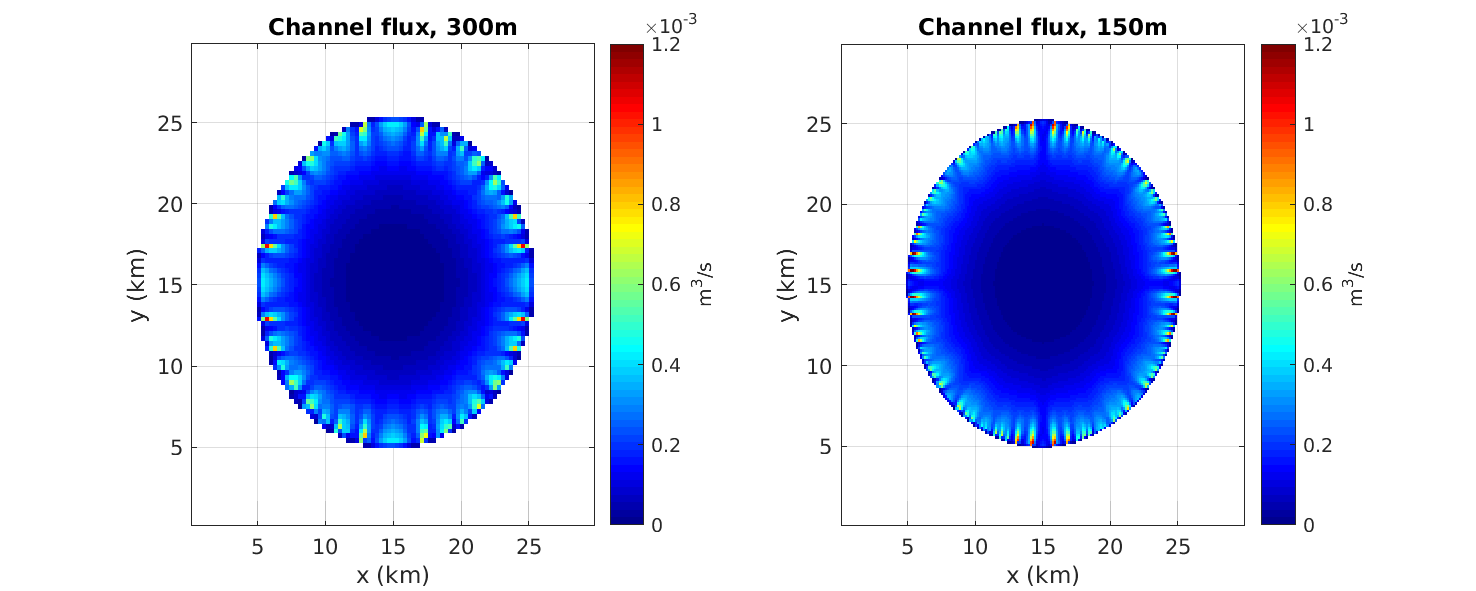Miscellaneous
Here are some lines of research that didn’t get their own page.
Subglacial hydrology
There is extensive water at the base of ice sheets, in some cases produced by drainage of supraglacial melt through crevasses and moulins, and in other cases generated by frictional heating and geothermal flux at the ice base. The Edinburgh Cryosphere group is a leading centre of expertise in subglacial hydrological research and I have been fortunate enough to be included in a number of exciting studies and projects.

The above image from Tedstone et al 2015 shows how complicated the dynamics of subglacial hydrology are. Focussing on a large, land-terminating sector in southwest Greenland, the study shows that despite supraglacial melt increases, which suggest high speeds in the spring and summer, annually-averaged velocity has decreased. This is because the same influx of water which leads to those high speeds causes a more efficient drainage system, which slows down the ice sheet in the late autumn and winter – and the increased slowdown has a stronger effect.
I am very lucky to be a part of two fantastic projects focussing on subglacial hydrology. 4DAntarctica aims to characterise the subglacial environment of Antarctica. My role with postdoc Dr Martin Wearing is to derive melt rates from frictional heating, which requires inverse modelling to infer basal velocities and drag. By examining subglacial melt and transport at the continental scale, as well as focused studies on dynamic regions, we will construct a coherent picture of how water moves throughout the underside of the ice sheet, and how it impacts ice dynamics. A further aim is to identify subglaial processes relating to ice-ocean interactions, as freshwater runoff provides a strong source of buoyancy to ice-shelf cavities.
The other project is MII-Greenland which aims to develop state of the art supra- and subglacial hydrological components within the UKESM ice-sheet model BISICLES. The model will benefit from the adaptive mesh framework within BISICLES, allowing high resolution where needed. It has also given me an excuse to learn how to implement the governing subglacial hydrological equations. In the image below, the equations of Hewitt et al 2013 have been applied to a radially symmetric ice sheet to investigate resolution effects on channels. In the .gif, a “sheet only” version of the equations has been applied to Thwaites Glacier (but assuming a constant melt rate); the sheet evolves from an initial thickness of zero over several years.


Ice shelves and biology
Melting of ice shelves in Antarctica is not only relevant to buttressing of ice sheets, it can also provide nutrients to primary ocean producers in nutrient-limited environments. The upper ocean on the Antarctic continental shelf is low in iron, a micronutrient vital to phytoplankton growth and fixing of atmospheric carbon. Recent studies suggest that strongly melting ice shelves in the Amundsen deliver iron to light-penetrating layers, due to the induced upwelling of Circumpolar Deep Water and due to melting of iron-rich particulate entrained in the ice sheet base.

PhD student Andrew Twelves has been applying MITgcm together with the BLING biogeochemistry code to a model of the ice-ocean interaction on the Antarctic continental shelf to investigate these processes. In the absence of ice-shelf melt there is almost no productivity (dashed line), because o a lack of upwelling of iron-containing CDW. Melting brings iron to the upper 100m driving much stronger productivity in the summer months (dash-dot line); while the addition of iron from melting-out of particulate greatly increases the upper ocean iron content but marginally increases productivity.

Mountain glaciers
Though my background is in numerical simulations of marine ice sheets during my time in Edinburgh I’ve been pulled into studies of glacier dynamics in High Mountain Asia, something I have truly enjoyed. Through cosupervision of PhD student Rosie Bisset I’ve learned quite a bit about debris-covered glaciers. For teaching I have written a GUI-based python program using the tkinter package to examine temperature fluctuations in response to diurnal climate variations based on Nicholson and Benn (2006); feel free to download it:
script
instructions

More recently Amaury Dehecq included me in a fantastic paper which uses a wealth of remote sensing data to give insight into the basal properties of glaciers from velocity response to thinning over a large number of glaciers.
Currently I am a co-investigator on the CSSP China project SWARM (Impacts Assessment to Support WAter Resources Management and Climate Change Adaptation for China). In this project improved climate projections of the 21st century over East Asia will be downscaled and used to drive a model of glacier evolution to project runoff and glacier loss. It is quite an interesting project given the importance of Asian glaciers to water security in the region. The model we will use is the Open Global Glacier Model (oggm). oggm is a very powerful code, developed in python, which allows the user to quickly process data and generate simulations for large numbers of glaciers, and the developers are incrediby helpful – the more I learn about it, the more I like it!
